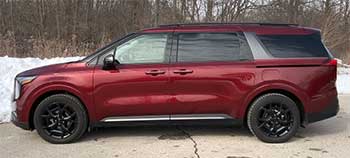As a parent juggling school runs, weekend trips, and the occasional road adventure, I’ve spent countless hours researching the perfect minivan. The 2025 Kia Carnival Hybrid and Toyota Sienna Hybrid stand out as top contenders, blending fuel efficiency with family-friendly features.
My goal here is to share my firsthand insights, weighing their pros and cons to help you decide which hybrid minivan suits your lifestyle. From cargo space to tech, I’ve explored every angle to make your choice easier.

Comparison Table: Kia Carnival Hybrid vs. Toyota Sienna Hybrid
| Feature | Kia Carnival Hybrid (2025) | Toyota Sienna Hybrid (2025) |
| Starting MSRP | $40,800 | $39,185 |
| Powertrain | 1.6L Turbo 4-cylinder + electric motor, 242 hp | 2.5L 4-cylinder + electric motors, 245 hp |
| Transmission | 6-speed automatic | eCVT |
| Fuel Economy (MPG) | 34 city / 31 highway / 33 combined | 36 city / 36 highway / 36 combined |
| Drivetrain | Front-wheel drive | Front-wheel or all-wheel drive |
| Cargo Space (cu. ft.) | 40.2 (seats up), 145.1 (seats folded) | 33.5 (seats up), 101.0 (seats folded) |
| Seating Capacity | Up to 8 | Up to 8 |
| Infotainment Screen | 12.3-inch touchscreen | 9.0-inch touchscreen |
| Warranty | 5-yr/60,000-mile basic, 10-yr/100,000-mile powertrain | 3-yr/36,000-mile basic, 5-yr/60,000-mile powertrain |
| Key Safety Features | Forward collision warning, surround-view camera | Toyota Safety Sense 2.0, 10 airbags |
| Unique Features | VIP Lounge seating, larger cargo area | Optional AWD, built-in vacuum, fridge (top trims) |
My Journey with Minivans
I’ve always been a fan of minivans for their sheer practicality. Growing up, my family had a clunky old van that hauled us to soccer games and camping trips, and I swore I’d never drive one as an adult. But life has a way of changing plans—two kids and a dog later, I’m a minivan convert. The hybrid minivan segment, in particular, caught my eye.
With gas prices fluctuating and environmental concerns on my mind, the Kia Carnival Hybrid and Toyota Sienna Hybrid emerged as frontrunners. Both promise fuel efficiency without sacrificing space or comfort, but each has its own personality. My quest was to find out which one fits the chaos of family life better.
Powertrain and Performance

Let’s talk about what’s under the hood. The Kia Carnival Hybrid pairs a 1.6-liter turbocharged four-cylinder with a 54-kW electric motor, delivering 242 horsepower and 271 lb-ft of torque.
It’s zippy enough for merging onto highways, even with a full load of passengers.
The six-speed automatic transmission feels smoother than I expected, avoiding the rubbery sensation of some hybrid systems. On a test drive, I noticed the Carnival’s powertrain is a bit grumbly under hard acceleration, but it settles down nicely for cruising.

The Toyota Sienna Hybrid, on the other hand, uses a 2.5-liter four-cylinder engine with two electric motors (three with AWD), producing a slightly higher 245 horsepower.
Its electronically controlled continuously variable transmission (eCVT) is seamless but can feel a bit sluggish during quick maneuvers.
I took a Sienna on a weekend trip, and while it didn’t thrill me with speed—7.5 seconds to hit 60 mph—it offered a refined, quiet ride. The Sienna’s hybrid system shines in stop-and-go traffic, where it feels effortless.
Pros of Kia Carnival Hybrid:
- Stronger torque for quicker low-end response.
- Conventional six-speed automatic feels familiar.
- Respectable acceleration for a minivan.
Cons of Kia Carnival Hybrid:
- Engine noise can be intrusive during hard acceleration.
- No all-wheel drive option, a drawback in snowy regions.
Pros of Toyota Sienna Hybrid:
- Smoother, quieter powertrain in most conditions.
- Available AWD, a game-changer for winter driving.
- Proven hybrid reliability from Toyota’s decades of expertise.
Cons of Toyota Sienna Hybrid:
- Sluggish acceleration compared to non-hybrid competitors.
- eCVT may feel less engaging for spirited drivers.
Fuel Efficiency
Fuel economy is a big deal for me, especially with weekly commutes and long family road trips. The Sienna shines here, boasting an EPA-estimated 36 mpg combined (35 mpg with AWD). In real-world driving, I hit close to 42 mpg on a highway-heavy trip, which is phenomenal for a vehicle this size. That kind of efficiency can save hundreds annually, especially with gas prices hovering around $3.50 a gallon.
The Kia Carnival Hybrid isn’t far behind, with 33 mpg combined (34 city, 31 highway). On a mixed route, I averaged about 32 mpg, which is solid but doesn’t match the Sienna’s numbers. The gap may seem small, but over years of ownership, it adds up—potentially $500-$800 in fuel savings with the Sienna, depending on your driving habits.
Pros of Kia Carnival Hybrid:
- Competitive fuel economy for a hybrid minivan.
- Turbo engine offers a balance of power and efficiency.
Cons of Kia Carnival Hybrid:
- Falls short of Sienna’s class-leading mpg.
- Real-world highway efficiency lags slightly.
Pros of Toyota Sienna Hybrid:
- Best-in-class fuel economy at 36 mpg combined.
- Exceptional real-world efficiency, especially on highways.
Cons of Toyota Sienna Hybrid:
- Slightly less power than the Carnival, which may affect efficiency under heavy loads.
Interior Space and Comfort
Minivans are all about space, and both of these deliver, though in different ways. The Kia Carnival Hybrid feels like a luxury lounge, especially with the optional VIP Lounge seating package. These second-row captain’s chairs recline, offer power-adjustable footrests, and make long drives feel like first-class flights. However, they’re heavy and don’t slide easily, which can make third-row access tricky for kids. The Carnival’s third row is comfortable but a bit tight on legroom (35.6 inches). Its cargo space is a standout—40.2 cubic feet with seats up and 145.1 cubic feet with seats folded. I easily fit a stroller, groceries, and sports gear without folding the third row.
The Toyota Sienna Hybrid prioritizes practicality. Its second-row captain’s chairs slide an impressive 25 inches, offering flexibility for legroom or cargo. However, they’re not removable, which limits maximum cargo space to 101 cubic feet—still generous but less than the Carnival. The Sienna’s third row offers more legroom (38.7 inches), which taller teens appreciated during a test drive. The interior feels airy, with a massive center console and 18 cupholders (yes, I counted). My kids loved the optional rear-seat entertainment system, though I wish it were standard on lower trims.
Pros of Kia Carnival Hybrid:
- Spacious cargo area, best-in-class at 145.1 cubic feet.
- VIP Lounge seats add a premium touch.
- Modern, SUV-like interior design.
Cons of Kia Carnival Hybrid:
- Second-row seats are heavy and less flexible.
- Third-row legroom is slightly cramped.
Pros of Toyota Sienna Hybrid:
- Roomier third row for taller passengers.
- Versatile second-row seating with long slide range.
- Abundant small-item storage for family chaos.
Cons of Toyota Sienna Hybrid:
- Less maximum cargo space than the Carnival.
- Second-row seats aren’t removable.
Technology and Infotainment
Tech is where the Kia Carnival Hybrid flexes its muscles. The standard 12.3-inch touchscreen is crisp and responsive, with wireless Apple CarPlay and Android Auto that connected seamlessly to my phone. The interface feels modern, though the capacitive buttons for climate and audio controls took some getting used to—I accidentally turned up the AC instead of the music more than once. Higher trims offer a surround-view camera and a rear-seat monitoring system, which gave me peace of mind with kids in the back.
The Sienna’s 9.0-inch touchscreen feels a bit dated by comparison, with lower resolution and a simpler interface. It still supports wireless Apple CarPlay and Android Auto, which worked flawlessly, but the smaller screen and basic graphics didn’t wow me. The Sienna fights back with unique features like an optional in-car vacuum cleaner (a lifesaver for crumbs) and a fridge on top trims. Both vans offer robust safety suites, but the Sienna’s Toyota Safety Sense 2.0 feels more polished, with smoother adaptive cruise control.
Pros of Kia Carnival Hybrid:
- Larger, more modern 12.3-inch touchscreen.
- Advanced safety features like Highway Driving Assist 2.
- Rear-seat monitoring camera is a parent’s dream.
Cons of Kia Carnival Hybrid:
- Capacitive buttons can be finicky.
- Infotainment interface has a slight learning curve.
Pros of Toyota Sienna Hybrid:
- Practical features like in-car vacuum and fridge.
- Intuitive safety tech with Toyota Safety Sense 2.0.
- Reliable connectivity with Apple CarPlay and Android Auto.
Cons of Toyota Sienna Hybrid:
- Smaller, dated 9.0-inch touchscreen.
- Rear-seat entertainment system not standard on lower trims.
Safety and Reliability
Safety is non-negotiable for me, and both minivans deliver. The Kia Carnival Hybrid comes with forward collision warning, lane departure warning, and a surround-view camera. Its Highway Driving Assist 2 adds semi-autonomous driving capabilities, which felt confident on long highway stretches. However, Kia’s reliability track record is less proven than Toyota’s, and while the Carnival hasn’t had major issues, I worry about long-term dependability.
The Toyota Sienna Hybrid earns a 5-star NHTSA safety rating, with 10 standard airbags and Toyota Safety Sense 2.0, including adaptive cruise control and pedestrian detection. Toyota’s hybrid systems are battle-tested, and my 2007 Sienna ran flawlessly for over 200,000 miles. The Sienna’s reliability gives me confidence for long-term ownership.
Pros of Kia Carnival Hybrid:
- Comprehensive safety suite with advanced features.
- Long warranty (10-year/100,000-mile powertrain).
Cons of Kia Carnival Hybrid:
- Less established reliability compared to Toyota.
- Fewer standard airbags than the Sienna.
Pros of Toyota Sienna Hybrid:
- Top-tier 5-star NHTSA safety rating.
- Proven hybrid reliability from Toyota’s legacy.
- Two years of complimentary maintenance.
Cons of Toyota Sienna Hybrid:
- Shorter warranty than the Carnival.
- Some advanced features limited to higher trims.
Pricing and Value
The Kia Carnival Hybrid starts at $40,800, slightly higher than the Sienna’s $39,185. However, the Carnival’s base LXS trim feels more upscale, with features like a 12.3-inch touchscreen and synthetic leather. A fully loaded Carnival SX Prestige Hybrid tops out at $53,995, offering leather upholstery and a 12-speaker Bose system. The Carnival’s longer warranty (5-year/60,000-mile basic, 10-year/100,000-mile powertrain) adds value for families planning to keep it long-term.
The Sienna’s base LE trim is well-equipped but basic, with cloth seats and a smaller screen. The top-tier Platinum trim hits $58,355, pricier than the Carnival but includes AWD and luxury touches like a fridge. Toyota’s two-year complimentary maintenance plan is a nice perk, but the shorter warranty (3-year/36,000-mile basic) feels less generous.
Pros of Kia Carnival Hybrid:
- Lower starting price for feature-rich trims.
- Best-in-class warranty coverage.
- More upscale interior at lower price points.
Cons of Kia Carnival Hybrid:
- No AWD option increases cost in snowy climates.
- Higher trims approach Sienna’s price.
Pros of Toyota Sienna Hybrid:
- Slightly lower starting MSRP.
- Complimentary maintenance for two years.
- AWD option adds value for specific climates.
Cons of Toyota Sienna Hybrid:
- Shorter warranty than the Carnival.
- Top trims are pricier with fewer luxury features.
Driving Experience
Driving the Kia Carnival Hybrid feels surprisingly planted for a minivan. Its suspension absorbs bumps well, though it leans more in corners than the Sienna. The steering is light but precise, making parking lot maneuvers a breeze. On a family trip, the Carnival’s quieter cabin (especially in higher trims) impressed me, though the engine’s grumble was noticeable during quick passes.
The Sienna’s ride is smoother, with a suspension that handles speed bumps better. It stays flatter in corners, and the optional AWD gave me confidence on a rainy day. However, the Sienna’s powertrain can drone under acceleration, which was mildly annoying on long drives.
Pros of Kia Carnival Hybrid:
- Quiet cabin in higher trims.
- Confident handling for a minivan.
- Smooth six-speed transmission.
Cons of Kia Carnival Hybrid:
- Engine noise under hard acceleration.
- No AWD limits versatility.
Pros of Toyota Sienna Hybrid:
- Smoother ride over rough roads.
- AWD enhances traction in adverse conditions.
- Quiet at cruising speeds.
Cons of Toyota Sienna Hybrid:
- Powertrain droning during acceleration.
- Less engaging handling than the Carnival.
My Take on Which Minivan Wins
After test-driving both, I’m torn. The Kia Carnival Hybrid feels like a modern, stylish choice with its massive touchscreen, upscale interior, and cavernous cargo space. It’s perfect for families who prioritize tech and flexibility, especially if you don’t need AWD. But its slightly lower fuel economy and unproven reliability give me pause.
The Toyota Sienna Hybrid, meanwhile, is the practical, dependable choice. Its superior fuel economy, available AWD, and proven track record make it a safe bet for long-term ownership, especially in harsher climates. If I lived in a snowy area, the Sienna’s AWD would seal the deal. Ultimately, your choice depends on your priorities—tech and space with the Carnival or efficiency and reliability with the Sienna.
Frequently Asked Questions (FAQ)
Yes, if you value a modern interior, large cargo space, and a long warranty. It’s a great value for tech-savvy families.
The Kia Carnival Hybrid gets 33 mpg combined, while the Toyota Sienna Hybrid achieves 36 mpg combined (35 with AWD).
No, the Kia Carnival has more cargo space (40.2 vs. 33.5 cubic feet with seats up, 145.1 vs. 101.0 folded). The Sienna has more third-row legroom.
The Toyota Sienna Hybrid is better for fuel economy and AWD availability. The Chrysler Pacifica Hybrid offers plug-in capability for short electric range.
Conclusion
Choosing between the Kia Carnival Hybrid and Toyota Sienna Hybrid isn’t easy, but I hope my experience helps you find the right fit. If you crave a stylish, tech-packed minivan with massive cargo space, the Carnival is your match. If fuel efficiency, reliability, and AWD are your priorities, the Sienna takes the crown. Consider your family’s needs—whether it’s snowy commutes or long road trips—and you’ll find the perfect hybrid minivan for your journey.

